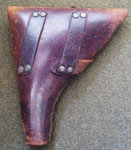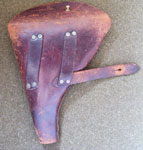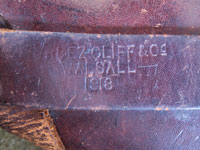Accoutrements, Naval, Pattern 1901 - Components
Equipment & Equipment Carriers

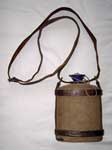

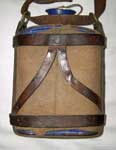 The Carriage, water-bottle. (Mark I.) Brown leather; with shoulder strap was approved on 8th August 1901 as part of the Accoutrements, naval, Pattern 1901 announcedby List of Changes paragraph §11110 of 1st July 1902. It was described as being similar in form to that shown in L. of C. §4974 (Carriage, water-bottle, Italian) but with a ring each side at the top to allow the shoulder strap to freely pass through. A metal clip was provided to pass behind the waist belt for steadying purposes. It was further mentioned that water-bottle was of a new design, the particulars of which were to be published shortly. [It was, in fact, not until March 1903 that L. of C. §11460 announced the Bottle, water, enameled. (Mark V.), common to both services.]
The Carriage, water-bottle. (Mark I.) Brown leather; with shoulder strap was approved on 8th August 1901 as part of the Accoutrements, naval, Pattern 1901 announcedby List of Changes paragraph §11110 of 1st July 1902. It was described as being similar in form to that shown in L. of C. §4974 (Carriage, water-bottle, Italian) but with a ring each side at the top to allow the shoulder strap to freely pass through. A metal clip was provided to pass behind the waist belt for steadying purposes. It was further mentioned that water-bottle was of a new design, the particulars of which were to be published shortly. [It was, in fact, not until March 1903 that L. of C. §11460 announced the Bottle, water, enameled. (Mark V.), common to both services.]
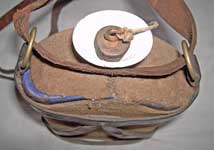 The L. of C. entry, as was often the case, is frustratingly brief and misses several important points. Apart from the points mentioned above, the Carriage, water-bottle. (Mark I.) differed significantly from the Carriage, water-bottle, Italian in that the upper band has no buckle and there is a leather back strap split to form an inverted “V” that is riveted to the centre of the top band and to the sides at the junction of the lower band and side straps. The belt clip is formed from an extension of the back strap, folded back down, on the inside of which, is sewn a leather pocket containing a brass insert. It should also be noted that the shoulder strap now formed a separate item attached to the Carriage only through the rings. As far as the modern researcher goes, excluding the back strap & clip, the Carriage, water-bottle (Mark I.) is very similar to the Land Service Carrier, waterbottle. (Mark I.) and it’s associated Straps, shoulder.
The L. of C. entry, as was often the case, is frustratingly brief and misses several important points. Apart from the points mentioned above, the Carriage, water-bottle. (Mark I.) differed significantly from the Carriage, water-bottle, Italian in that the upper band has no buckle and there is a leather back strap split to form an inverted “V” that is riveted to the centre of the top band and to the sides at the junction of the lower band and side straps. The belt clip is formed from an extension of the back strap, folded back down, on the inside of which, is sewn a leather pocket containing a brass insert. It should also be noted that the shoulder strap now formed a separate item attached to the Carriage only through the rings. As far as the modern researcher goes, excluding the back strap & clip, the Carriage, water-bottle (Mark I.) is very similar to the Land Service Carrier, waterbottle. (Mark I.) and it’s associated Straps, shoulder.
The illustrated example is not true to pattern as it has never had a belt clip. There are no markings on it to give any clue to its origin. It does however nicely illustrate the “V” back strap & Bottle, water, enameled. (Mark V.). The shoulder strap is a later replacement. From the Chris Pollendine collection. Photos © Chris Pollendine 2011.
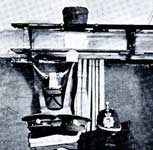 Interestingly, a Carriage identical to Chris’s is shown in this kit layout photo from Army Service Corps Training, Part 1 1909, kindly provided by John Bodsworth. What a Naval style Carriage water bottle is doing in an Army kit layout is a mystery. We at KW would welcome any additional information on this.
Interestingly, a Carriage identical to Chris’s is shown in this kit layout photo from Army Service Corps Training, Part 1 1909, kindly provided by John Bodsworth. What a Naval style Carriage water bottle is doing in an Army kit layout is a mystery. We at KW would welcome any additional information on this.
Carriage, waterbottle. (Mark II).
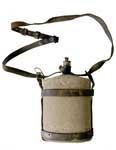
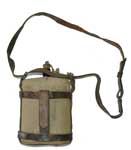 The Carriage, water-bottle. (Mark II.) Brown leather; with shoulder strap was approved early in 1903 and announced by List of Changes paragraph § 11659 of 1st July 1903. It was described as differing from the previous pattern (L. of C. § 11110) in that it had the shoulder strap slightly altered to prevent it from being detached from the Carriage. This is one of those frustratingly brief L. of C. entries that don’t tell us much at all. By contrast, when a similar alteration was carried out to the Land Service Carrier, water-bottle in September 1905, the L. of C. (§ 12994) description ran to almost a page! Simply(?) put the shoulder strap was fed through a small rectangular brass loop, turned back on itself with the free end passing through the buckle, then through the two loops on top of the Carriage and finally bent around the other side of the rectangular brass loop and riveted. This left no free end, thus preventing the shoulder strap from being removed.
The Carriage, water-bottle. (Mark II.) Brown leather; with shoulder strap was approved early in 1903 and announced by List of Changes paragraph § 11659 of 1st July 1903. It was described as differing from the previous pattern (L. of C. § 11110) in that it had the shoulder strap slightly altered to prevent it from being detached from the Carriage. This is one of those frustratingly brief L. of C. entries that don’t tell us much at all. By contrast, when a similar alteration was carried out to the Land Service Carrier, water-bottle in September 1905, the L. of C. (§ 12994) description ran to almost a page! Simply(?) put the shoulder strap was fed through a small rectangular brass loop, turned back on itself with the free end passing through the buckle, then through the two loops on top of the Carriage and finally bent around the other side of the rectangular brass loop and riveted. This left no free end, thus preventing the shoulder strap from being removed.
A much more obvious alteration of pattern to the Carriage, water-bottle. (Mark II.) Brown leather; with shoulder strap was approved on 7th November 1911 and announced by List of Changes § 15776 of 1st January 1912, in that the pattern of the above mentioned carriage had been modified to govern future manufacture & repair. The leather piece forming the back strap was to no longer be split in two and joined at the sides but was to be one solid piece 9 ¾-inches by 1-inch riveted to the top and bottom bands for additional strength. § 15776 goes on to state that the modification was to be carried out by Naval Ordnance Depôts when Carriages were undergoing repair. An uncharacteristically detailed set of instructions were included along with a list of stores required, that could be obtained by demand, from the Naval Ordnance Officer, Woolwich, if not available locally.
KW have not been able to locate a pre November 1911 example of a Carriage, water-bottle. (Mark II.) to photograph.
The Carriage, water-bottle. (Mark II.) illustrated above left incorporates the post November 1911 changes. It holds a Bottle, water, enameled (Mark VI.) (approved May 1903). From the Carl Woods collection. Photographs © Carl Woods 2011.
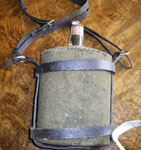

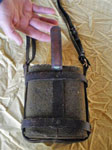
 This next Carriage, water-bottle. (Mark II.) is from the Larry & Diane Emrick Collection and also contains a Bottle, water, enameled (Mark VI.). It shows detail of the belt clip construction. Note that the shoulder strap on this Carriage has been replaced at some stage and is possibly from a Carriage, water-bottle. (Mark I). Photos © Diane Emrick 2011.
This next Carriage, water-bottle. (Mark II.) is from the Larry & Diane Emrick Collection and also contains a Bottle, water, enameled (Mark VI.). It shows detail of the belt clip construction. Note that the shoulder strap on this Carriage has been replaced at some stage and is possibly from a Carriage, water-bottle. (Mark I). Photos © Diane Emrick 2011.
The Case, pistol. (Mark I.) Brown leather was approved on 8th August 1901 as part of the Accoutrements, naval, Pattern 1901 announced by List of Changes paragraph §11110 of 1st July 1902. It was described as differing from the previous pattern (L. of C. §6434) in that it was made a little longer, with the loops on the back being in a different position and its shape being similar to that shown in L. of C. §10440 (Case, pistol “Sam Browne”). As is sometimes the case in L. of C. descriptions, the most significant thing was left out, being that the Case was designed for a left hand draw, which is opposite to its predecessor. It is believed that this was to facilitate drawing the pistol with the left hand when the right was occupied with the cutlass. The reason for the increase in length when the in service pistol was still the .455 inch calibre Pistol, Webley (Marks I to IV) with 4 inch barrels, is currently lost to history. The KWRT have not been able to locate an unmodified example of a Case, pistol. (Mark I.) to examine and photograph, so assistance in this area from readers would be appreciated. Working back from the Case, pistol. (Mark II.), which superseded it in June 1902, the Case, pistol. (Mark I.) should be around 9 ¾-inches high along the straight edge and 6 ¾-inches across at the widest point.
Case, pistol. (Mark II). UPDATED!
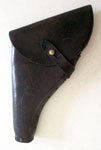


 The Case, pistol. (Mark II.) Brown leather was approved on 25th June 1902 and announced by List of Changes paragraph §11202 of 1st September 1902. It was described as differing from the previous pattern (L. of C. §11110) in that the muzzle portion was 1 ¼-inches shorter and the position of the upper back loop was slightly altered. The front of the case was also reduced to admit the revolver being more readily withdrawn. Mark I cases were to be altered locally, with a sample of an altered case supplied from Naval Ordnance Store, Woolwich as a guide. This was to be done in accordance with arrangements made by the Superintendent of Ordnance Stores. An example of a Case, pistol. (Mark I.) altered to Mark II, as per §11202 is shown at left. Originally manufactured by A. Ross & Co in 1901, it is from the Chris Pollendine collection. Photos © Chris Pollendine 2014.
The Case, pistol. (Mark II.) Brown leather was approved on 25th June 1902 and announced by List of Changes paragraph §11202 of 1st September 1902. It was described as differing from the previous pattern (L. of C. §11110) in that the muzzle portion was 1 ¼-inches shorter and the position of the upper back loop was slightly altered. The front of the case was also reduced to admit the revolver being more readily withdrawn. Mark I cases were to be altered locally, with a sample of an altered case supplied from Naval Ordnance Store, Woolwich as a guide. This was to be done in accordance with arrangements made by the Superintendent of Ordnance Stores. An example of a Case, pistol. (Mark I.) altered to Mark II, as per §11202 is shown at left. Originally manufactured by A. Ross & Co in 1901, it is from the Chris Pollendine collection. Photos © Chris Pollendine 2014.


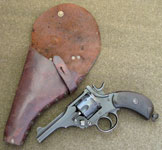
 Another example of the Case, pistol. (Mark II.) Brown leather modified from a Mk. I Case. This Case is shown with the type of revolver it was designed to carry, a Webley Mk. IV. Photos © Karkee Web, 2019.
Another example of the Case, pistol. (Mark II.) Brown leather modified from a Mk. I Case. This Case is shown with the type of revolver it was designed to carry, a Webley Mk. IV. Photos © Karkee Web, 2019.
Like the example shown above, this Case was originally manufactured by A. Ross & Co in 1901. As recorded in Everything in Leather: The Story of Barrow, Hepburn and Gale (privately printed, 1948), the firm of Alexander Ross and Co. was founded "about 1820," and merged with Hepburn & Gale, Ltd., in 1903, to form Hepburn, Gale & Ross, Ltd.

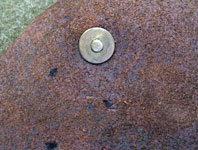
 It is interesting to note that both of these Pistol Cases are correctly naval marked in accordance with the Instructions as to Marking Naval Accoutrements (see excerpt at right). Photos © Karkee Web, 2019.
It is interesting to note that both of these Pistol Cases are correctly naval marked in accordance with the Instructions as to Marking Naval Accoutrements (see excerpt at right). Photos © Karkee Web, 2019.
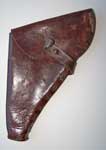

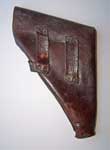 The next illustrated Case is earliest new made Mark II we have seen and is maker marked T. C. Galley 1902. It measures around 8 ½-inches high along the straight edge and 6 ¾-inches across at the widest point. From the John Lamont collection. Photos © John Lamont 2011.
The next illustrated Case is earliest new made Mark II we have seen and is maker marked T. C. Galley 1902. It measures around 8 ½-inches high along the straight edge and 6 ¾-inches across at the widest point. From the John Lamont collection. Photos © John Lamont 2011.


 Another Case, pistol. (Mark II.), this time by Hepburn Gale & Ross Ltd. 1904. From the John Bodsworth collection. Photos © John Bodsworth 2011.
Another Case, pistol. (Mark II.), this time by Hepburn Gale & Ross Ltd. 1904. From the John Bodsworth collection. Photos © John Bodsworth 2011.
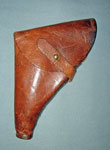
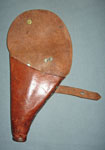
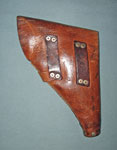 This Mk. II Pistol case is a NSC (Naval Service Canada?) marked example by Riley & McCormick Ltd. Calgary 1915. Photos © Karkee Web 2011.
This Mk. II Pistol case is a NSC (Naval Service Canada?) marked example by Riley & McCormick Ltd. Calgary 1915. Photos © Karkee Web 2011.
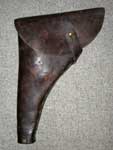

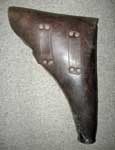 The Case, pistol. (Mark III.) Brown leather was approved on 3rd July 1915 and announced by List of Changes paragraph §17417 of 1st September 1915. It was described as differing from the previous pattern (L. of C. §11202) in that the muzzle portion was about 1 ½-inches longer and also it was 1-inch wider in the top and flap. These changes were to accommodate the Pistols, Webley with 6-inch barrel (Mark VI.) and the 6-inch barrel derivatives of the earlier Marks.
The Case, pistol. (Mark III.) Brown leather was approved on 3rd July 1915 and announced by List of Changes paragraph §17417 of 1st September 1915. It was described as differing from the previous pattern (L. of C. §11202) in that the muzzle portion was about 1 ½-inches longer and also it was 1-inch wider in the top and flap. These changes were to accommodate the Pistols, Webley with 6-inch barrel (Mark VI.) and the 6-inch barrel derivatives of the earlier Marks.
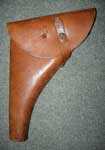

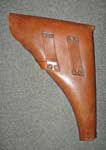 The "about 1 ½-inches longer" mentioned in the L. of C. is considerably less than the difference of 2 ½-inches in length between a Mark II and a Mark III Case, pistol, as measured on existent examples. The Case, pistol. (Mark III.) is 11-inches high along the straight edge and 7 ¾-inches across at the widest point. The first of the illustrated examples is by Jas. Dawson & Son Ltd. 1916 and although Navy marked must have strayed from its intended service having been owned at some stage by LT P. Rourke RAF. The second example is Australian made by CGHF. Both Cases are from the Graham Tweeddale Collection, photos © Graham Tweeddale 2011.
The "about 1 ½-inches longer" mentioned in the L. of C. is considerably less than the difference of 2 ½-inches in length between a Mark II and a Mark III Case, pistol, as measured on existent examples. The Case, pistol. (Mark III.) is 11-inches high along the straight edge and 7 ¾-inches across at the widest point. The first of the illustrated examples is by Jas. Dawson & Son Ltd. 1916 and although Navy marked must have strayed from its intended service having been owned at some stage by LT P. Rourke RAF. The second example is Australian made by CGHF. Both Cases are from the Graham Tweeddale Collection, photos © Graham Tweeddale 2011.

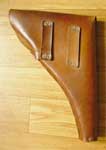 The Case, pistol (Mark III.) was destined to have a long service life and was again put into production in the early years of the Second World War. This example is by BHG (Barrow Hepburn & Gale) 1942. From the Luc Inion collection. Photos © Luc Inion 2011.
The Case, pistol (Mark III.) was destined to have a long service life and was again put into production in the early years of the Second World War. This example is by BHG (Barrow Hepburn & Gale) 1942. From the Luc Inion collection. Photos © Luc Inion 2011.
Case, pistol comparison Mark II to Mark III
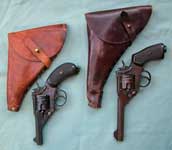
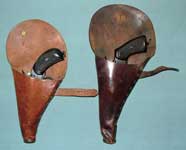 At left are side-by-side photographs of a Case, pistol. (Mark II.) and (Mark. III) along with typical Pistols, Webley (Mark. IV) and (Mark VI.) for comparison. The Mark II Case is the Riley & McCormick example described above while the Mark III Case is completely unmarked except for a lone broad arrow over 46 under the flap, which is presumed to be an inspector’s mark. Photographs © Karkee Web 2011.
At left are side-by-side photographs of a Case, pistol. (Mark II.) and (Mark. III) along with typical Pistols, Webley (Mark. IV) and (Mark VI.) for comparison. The Mark II Case is the Riley & McCormick example described above while the Mark III Case is completely unmarked except for a lone broad arrow over 46 under the flap, which is presumed to be an inspector’s mark. Photographs © Karkee Web 2011.
Accoutrements, naval, pattern 1912 -
Case, pistol, Mark I.
The Accoutrements naval pattern 1912 consisted of only two items, the Case, pistol & the Pouch, cartridge, pistol and were intended to be worn with the with the Accoutrements naval pattern 1901, hence their inclusion here.
The Case, pistol, Mark I. Brown leather was approved on 31st May 1912, as part of the Accoutrements, naval, Pattern 1912 announcedby List of Changes §16043 of 1st August 1912, and was intended for the carriage of the Webley and Scott Automatic pistol. It was described as being similar in shape to the 1901 pattern but larger. At 10 ¼-inches long by 8 ½-inches at its widest point it is certainly that, being longer and wider than the pattern 1901 Case pistol (Mark II.). Strangely, the L. of C. entry didn’t note the biggest difference between the two in that the Patt. '12 Case, pistol is designed for right handed draw where as the Patt. '01 is left handed. Fortunately KWRT member Peter Smith was able to offer an explanation by way of a quote from Admiralty (Gunnery Branch) pamphlet The Webley-Scott Automatic Pistol – description, action, directions for parting and drill G. 12985/16 of 1916, which states “The Webley-Scott pistol is supplied for the use of destroyers and torpedo boats where the sword will not be worn, and therefore is carried at the left side”.
It would appear that the Royal Navy showed considerable foresight in adopting the Case, pistol almost a year in advance of the Pistol, self-loading, Webley and Scott, .455-inch, Mark I, which was not formally approved until 19th May 1913, as announced by L. of C. §16403. The reality is that the decision to adopt the Webley Scott pistol had already been taken by early 1912.1 As with the pattern 1901 Accoutrements, there appears to be no L. of C. entry or other documentation that has come to light, identifying when it was declared obsolete.

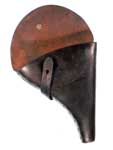
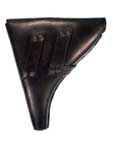 The first example of an early Case, pistol, Mark I is maker marked "Middlemore & Lamplugh Ld, 1912, Birmingham". The Case (which is a very dark brown, rather than black) has no military markings on it, but given that that it came (via his son's widow) from Midshipman Felix John Mossop who served in the RN in WWI, it is more than likely an issue item. His Pouch, cartridge, pistol is illustrated on the Ammunition Carrier page. Midshipman Mossop served on Coastal Motor Boats and was awarded the Belgian Croix de Guerre after Zeebrugge. From the Peter Smith collection. Photographs © Peter Smith 2011.
The first example of an early Case, pistol, Mark I is maker marked "Middlemore & Lamplugh Ld, 1912, Birmingham". The Case (which is a very dark brown, rather than black) has no military markings on it, but given that that it came (via his son's widow) from Midshipman Felix John Mossop who served in the RN in WWI, it is more than likely an issue item. His Pouch, cartridge, pistol is illustrated on the Ammunition Carrier page. Midshipman Mossop served on Coastal Motor Boats and was awarded the Belgian Croix de Guerre after Zeebrugge. From the Peter Smith collection. Photographs © Peter Smith 2011.

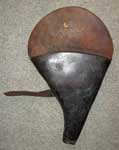

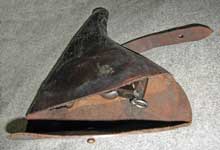 The next two illustrated examples here are, firstly one by J. B. Brooks & Co 1915, and the second by T. C. Galley 1914.
The next two illustrated examples here are, firstly one by J. B. Brooks & Co 1915, and the second by T. C. Galley 1914.
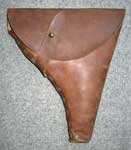

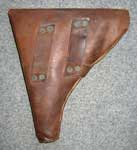 It is interesting to note that Galley made Cases are constructed of thinner leather, being over an ounce lighter than the Brooks product. Both Cases are from the Graham Tweeddale Collection, photos © Graham Tweeddale 2011.
It is interesting to note that Galley made Cases are constructed of thinner leather, being over an ounce lighter than the Brooks product. Both Cases are from the Graham Tweeddale Collection, photos © Graham Tweeddale 2011.
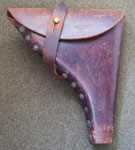
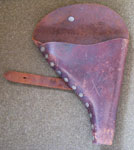 Another example, this a late war dated one made by Jabez Cliff & Co., Walsall, 1918. It is of interest that this case differs in several ways to the earlier examples, notably in the profile of the upper edge, the size of the flap, the end of the closure billet protruding beyond the belt loop plus the fact the belt loops are sized to be able to take a 3-inch Belt and positioned differently. It is felt that these variations are too major to be passed off as manufacturing differences but, as yet, the KWRT has been unable to uncover any documentation to explain them. We would be interested to hear from any reader who has a Patt 1912 Case, pistol of similar vintage or knows of related documentation. From the Terry Hawker Collection. Photos © Terry Hawker 2014.
Another example, this a late war dated one made by Jabez Cliff & Co., Walsall, 1918. It is of interest that this case differs in several ways to the earlier examples, notably in the profile of the upper edge, the size of the flap, the end of the closure billet protruding beyond the belt loop plus the fact the belt loops are sized to be able to take a 3-inch Belt and positioned differently. It is felt that these variations are too major to be passed off as manufacturing differences but, as yet, the KWRT has been unable to uncover any documentation to explain them. We would be interested to hear from any reader who has a Patt 1912 Case, pistol of similar vintage or knows of related documentation. From the Terry Hawker Collection. Photos © Terry Hawker 2014.
Footnote:
1. National Archives of Australia file MP472/1 819358, Small arms accoutrements for HMA Ships, adoption of Webley Scott Automatic pistol.
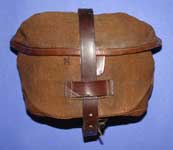
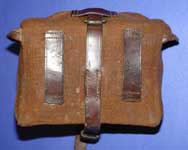 The Cover, mess tin. (Mark I.) Brown canvas, with 4 leather loops, was approved on 8th August 1901 as part of the Accoutrements, naval, Pattern 1901 announcedby List of Changes paragraph §11110 of 1st July 1902. Intended to carry the Mess tin. (Mark I.), introduced at the same time, the Cover, mess tin was described as made of brown dyed sail canvas, fitted with brass stud, one billet and four leather loops. The cap (flap) front was bound in leather. The Cover, mess tin (Mark I.) was to go on to be the most altered part of the Accoutrements, naval, Pattern 1901 being the subject of no less than three further List of Changes entries.
The Cover, mess tin. (Mark I.) Brown canvas, with 4 leather loops, was approved on 8th August 1901 as part of the Accoutrements, naval, Pattern 1901 announcedby List of Changes paragraph §11110 of 1st July 1902. Intended to carry the Mess tin. (Mark I.), introduced at the same time, the Cover, mess tin was described as made of brown dyed sail canvas, fitted with brass stud, one billet and four leather loops. The cap (flap) front was bound in leather. The Cover, mess tin (Mark I.) was to go on to be the most altered part of the Accoutrements, naval, Pattern 1901 being the subject of no less than three further List of Changes entries.
List of Changes paragraph §11659, of 1st July 1903, announced the Cover, mess tin. (Mark I.) Brown canvas, with mess-tin strap sewn on, and four leather loops. As the name implies it was simply the same Cover, mess tin with the previously separate Strap, mess tin permanently attached. The mark numeral was not advanced. Existing stocks were to be altered locally, with a sample Cover issued to depots as a guide.
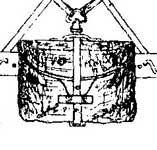 The strap was attached centrally to the back of the Cover with two short rows of vertical stitching so that, with the cap closed, the brass loop was over the rear top edge. This was so that when the Cover was fitted to the Belt the brass loop was in the correct position to receive the free end of the strap after it had been reeved through the ring on the Braces. See the accompanying illustration, which has been taken from the fitting instructions in Rifle and Field Exercises for His Majesty’s Fleet 1909.
The strap was attached centrally to the back of the Cover with two short rows of vertical stitching so that, with the cap closed, the brass loop was over the rear top edge. This was so that when the Cover was fitted to the Belt the brass loop was in the correct position to receive the free end of the strap after it had been reeved through the ring on the Braces. See the accompanying illustration, which has been taken from the fitting instructions in Rifle and Field Exercises for His Majesty’s Fleet 1909.
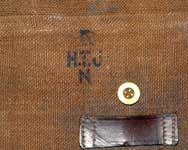 List of Changes paragraph §15390, of 1st March 1911 announced yet another change to the design of the Cover, mess tin. pattern 1901, Brown canvas, with leather loops, in that future production was to have a small brass button in lieu of the stud on the front, for fastening the flap. Existing Covers were to be altered at Naval Ordnance depots when undergoing repair. The astute reader will note that there is some inconsistent terminology here. These terms have been taken directly from the L. of C.. The reason for the inconsistency is not known but we assume it is simply the work of different staff. The illustrated example is of this variation. It appears not to be maker marked or dated. From the Ed Storey collection. Photographs © Ed Storey 2011.
List of Changes paragraph §15390, of 1st March 1911 announced yet another change to the design of the Cover, mess tin. pattern 1901, Brown canvas, with leather loops, in that future production was to have a small brass button in lieu of the stud on the front, for fastening the flap. Existing Covers were to be altered at Naval Ordnance depots when undergoing repair. The astute reader will note that there is some inconsistent terminology here. These terms have been taken directly from the L. of C.. The reason for the inconsistency is not known but we assume it is simply the work of different staff. The illustrated example is of this variation. It appears not to be maker marked or dated. From the Ed Storey collection. Photographs © Ed Storey 2011.
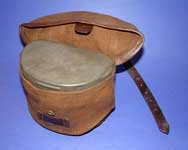 The button must have proved a bad idea as List of Changes paragraph §19481, of 1st November 1917 announced that the design of the Cover, mess tin. (Mark I.) Brown canvas, with mess-tin strap sewn on, and four leather loops (Note we are back to the "correct" terminology!) was modified to have a brass stud in lieu of the existing brass button. Existing stocks were to be used up unaltered.
The button must have proved a bad idea as List of Changes paragraph §19481, of 1st November 1917 announced that the design of the Cover, mess tin. (Mark I.) Brown canvas, with mess-tin strap sewn on, and four leather loops (Note we are back to the "correct" terminology!) was modified to have a brass stud in lieu of the existing brass button. Existing stocks were to be used up unaltered.



 The Frog. (Mark I.) Brown leather, with shifting loop, sword bayonet or cutlass.was approved on 8th August 1901 and announced as part of the Accoutrements, naval, Pattern 1901 by List of Changes paragraph §11110 of 1st July 1902. It was described as differing from the previous pattern (List of Changes §6434) in being smaller, with the front blocked up to enable it to take the scabbard and provided with a shifting loop and stud. It must have had some issues with scabbards pulling or falling out, as List of Changes §11659 of 1st July 1903 announced that lower portion was reduced in width 5/8-inch to fit the scabbard more tightly. The Mark number was not changed. The belt loop is 2-inches wide while the Frog is 2 ¼-inches at its widest point and 6 ¾-inches long overall. The KWRT have not been able to locate any pre 1903 examples of the Frog (Mark I) for comparison, or any dated later than 1918. Once again we seek help from our readership in this regard.
The Frog. (Mark I.) Brown leather, with shifting loop, sword bayonet or cutlass.was approved on 8th August 1901 and announced as part of the Accoutrements, naval, Pattern 1901 by List of Changes paragraph §11110 of 1st July 1902. It was described as differing from the previous pattern (List of Changes §6434) in being smaller, with the front blocked up to enable it to take the scabbard and provided with a shifting loop and stud. It must have had some issues with scabbards pulling or falling out, as List of Changes §11659 of 1st July 1903 announced that lower portion was reduced in width 5/8-inch to fit the scabbard more tightly. The Mark number was not changed. The belt loop is 2-inches wide while the Frog is 2 ¼-inches at its widest point and 6 ¾-inches long overall. The KWRT have not been able to locate any pre 1903 examples of the Frog (Mark I) for comparison, or any dated later than 1918. Once again we seek help from our readership in this regard.
The illustrated examples are by T. C. Galley 1903 (two photos far left) and Jabez Cliff & Co 1918 (two photos near left). Both are from the John Lamont collection. Photos © John Lamont 2011.
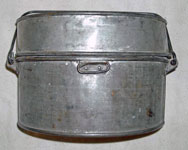
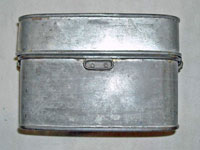 The Mess tin. (Mark I.) Tin: with brass wire handle was approved on 8th August 1901 along with the other Accoutrements, naval, pattern 1901, and announced by List of Changes paragraph §11110 of 1st July 1902. Described as D-shaped and consisting of a body, lid and tray. The lid having a tinned iron wire handle so it could be used as a frying pan and the tray fitting into the upper part of the body. While we at KW have not been able to examine a specifically naval marked Mess tin, we believe the Mess tin. (Mark I.) would be similar, if not identical, to the 1913 Canadian marked Land Service example illustrated, from the Karkee Web Collection. If any reader can help out here, with photos or more information, please do not hesitate to contact KW.
The Mess tin. (Mark I.) Tin: with brass wire handle was approved on 8th August 1901 along with the other Accoutrements, naval, pattern 1901, and announced by List of Changes paragraph §11110 of 1st July 1902. Described as D-shaped and consisting of a body, lid and tray. The lid having a tinned iron wire handle so it could be used as a frying pan and the tray fitting into the upper part of the body. While we at KW have not been able to examine a specifically naval marked Mess tin, we believe the Mess tin. (Mark I.) would be similar, if not identical, to the 1913 Canadian marked Land Service example illustrated, from the Karkee Web Collection. If any reader can help out here, with photos or more information, please do not hesitate to contact KW.
 The Mess tin. (Mark 1.) was destined for a long life being reissued with the Web Equipment pattern 19191 and presumably with the Web Equipment pattern 1908 after the general withdrawal of the rest of the Accoutrements, pattern 1901 in the early 1920’s.
The Mess tin. (Mark 1.) was destined for a long life being reissued with the Web Equipment pattern 19191 and presumably with the Web Equipment pattern 1908 after the general withdrawal of the rest of the Accoutrements, pattern 1901 in the early 1920’s.
Footnotes:
Graham Tweeddale 2011
